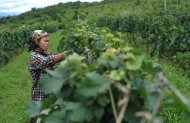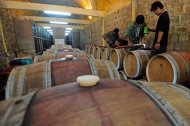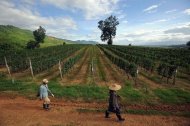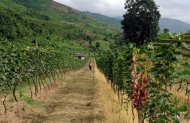Myanmar may be best known for its decades of junta
rule, but behind the bamboo curtain maverick entrepreneurs have toiled
for years to put the nation on the map for the quality of its wine.
Vines cascade down terraces overlooking the vast mirror of Inle Lake
in northeastern Myanmar, an unlikely setting for a budding wine industry
tempting the tastebuds of tourists now flocking to the country as it
opens up."Everybody is surprised to see a vineyard here in the middle of Myanmar with all this modern equipment," said Francois Raynal, winemaker at the Red Mountain estate in Shan State.
The vineyard, which produces roughly 120,000 bottles a year that fetch about 10,000 kyat ($11) apiece, has itself become a draw for foreigners intrigued that vines could grow in the tropical country.
Many visitors are Europeans with a "strong wine culture" who want to try the local tipple, said Raynal, a Frenchman who has worked at the winery for a decade.
Myanmar's wine pioneer was German Bert Morsbach, who spearheaded the country's original vineyard, Aythaya, after a colourful career in Southeast Asia.
He began working in Myanmar from 1989 exporting organic basmati rice, but turned to vines after the business was confiscated by a government minister.
In 1998 he planted 4,000 vines imported from France in eastern Karenni state, but a simmering insurgency between the army and ethnic rebels flared in the area and the government forbade him from tending his vineyard.
"That was my first experience with wine. Then 'I said I like it here, so much that I will give it another chance with another region up there in Shan State,'" Morsbach told AFP.
The challenges of wine growing in Myanmar are not just related to its complex political history.
Although it is known for its fertile soil, the country's tropical climate and relatively short days during the June-July peak budding period mean only a few grape types are able to thrive.
"Fungus is our biggest enemy. Greenhouse conditions here mean it often grows much better than grapes," said Hans Leiendecker, the German director of wine operations at Aythaya, which expected to sell 100,000 bottles in 2012 and double that number this year.
Shan State's clouded hills give the vineyard an elevation of around 1,100 metres (3,600 feet) above sea level, meaning the vines enjoy cooler temperatures than in other tropical areas.
"It's cold and that produces the nice aromas," Leiendecker said.
Consumers, however, seem to have more of a thirst for red wines and Aythaya has found that Shiraz grows well. It is also testing German Dornfelder, Tempranillo and Chianti.
Myanmar's winemakers have by necessity been "very experimental" and could develop well in the coming years, following in the footsteps of China, Thailand and India, said Denis Gastin, an Australia-based writer specialising in Asian wine.
He said the success of Myanmar's trailblazing vineyards has encouraged a number of smaller operations to bud -- a situation likely to please hoteliers clamouring for local wines.
"We are happy to present a product from our own land. Also it is a quality product. It is fantastic wine," said Yin Myo Su, who runs the upmarket Inle Princess hotel.
"I hope we won't be limited to two vineyards -- we could have 20," she said.
Myanmar's international image has seen dramatic improvement as it emerges from decades of military rule, with President Thein Sein taking office in 2011 and overseeing dramatic political reforms including the election of democracy champion Aung San Suu Kyi to parliament.
Foreigners have enthusiastically flooded in, filling hotels to capacity.
Red Mountain, owned by a Myanmar businessman, sells its wine predominantly at the country's tourist hot spots like Yangon, Mandalay and the ancient temple complex of Bagan.
But rival Aythaya's vineyard and restaurant is close to the bustling Shan state capital Taunggyi where the majority of custom is from locals, including wealthy businessmen.
The long-term nature of the business -- the number of bottles produced depends on crops planted several years before -- means that even if tourism soars, it will take years before it flows through into production.
But is the wine good?
Gastin tested the Red Mountain range at a tropical wine symposium last year and was "pretty impressed".
"I was quite shocked about the Sauvignon Blanc and Pinot Noir, I thought they were really very very good," he said.
At Red Mountain, Swiss vineyard owner Serge Heymoz -- who was visiting the estate while on holiday -- also gave the wine the seal of approval.
"It is very interesting indeed, but let's be clear -- interesting in a good way," he said.





ไม่มีความคิดเห็น:
แสดงความคิดเห็น